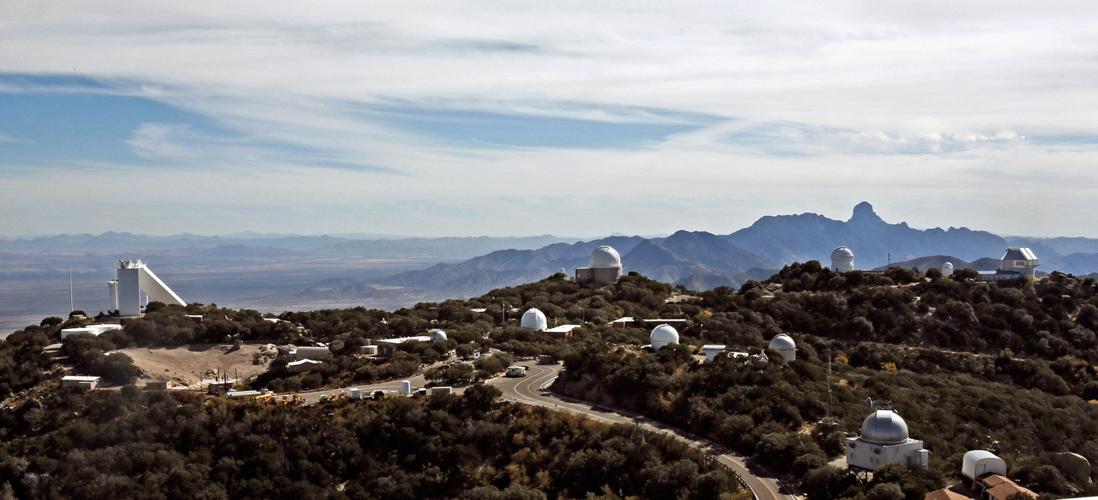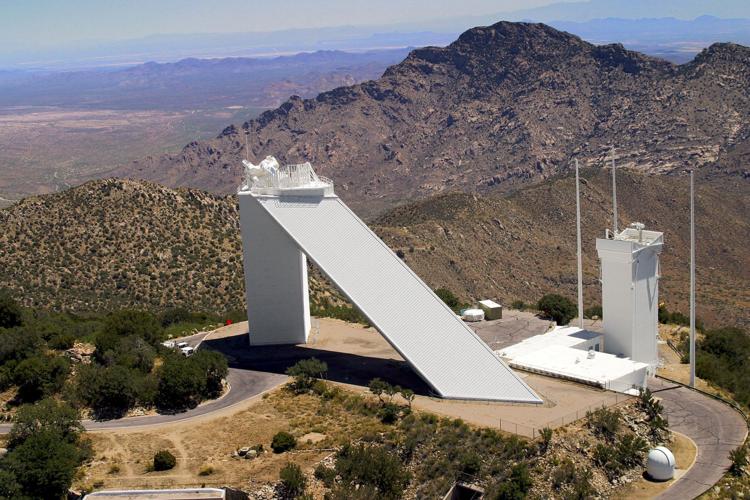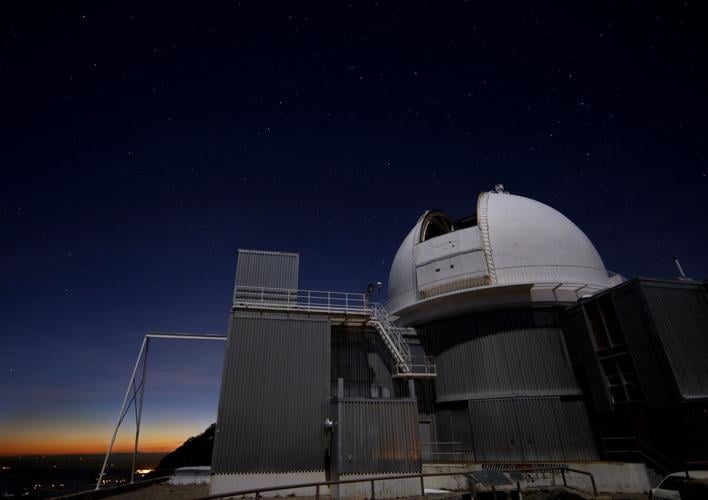The world’s largest solar telescope, the iconic McMath–Pierce atop Kitt Peak, has been eclipsed by newer technology and is headed toward eventual demolition if a last-ditch attempt to find a new operator for it is unsuccessful.
Elsewhere on the peak in the Quinlan Mountains, on the Tohono O’odham Nation 55 miles southwest of Tucson, the picture is sunnier.
Three telescopes whose future was threatened in 2012 when the National Science Foundation announced plans to defund them, have attracted new operators and $85 million to transform them into machines for exploring the pre-eminent riddles of astronomy — the effect of dark energy on the cosmos and the search for habitable worlds elsewhere in the universe.

A Dark Energy Spectrographic Instrument will be installed in the 18-story dome of the Mayall 4-meter telescope.
The 18-story dome of the Mayall 4-meter telescope will soon house a Dark Energy Spectrographic Instrument (DESI) capable of mapping 11.5 billion years of the evolution of the universe.
The U.S. Department of Energy is investing $70 million in that transformation, which is led by Lawrence Berkeley National Laboratory.
The smaller, but more technologically advanced, 3.5-meter WIYN Telescope, will soon house an $11 million “extreme radial velocity instrument,” funded by NASA and being built at Penn State, which will be able to detect and characterize unseen exoplanets by precisely measuring the wobbles they cause when orbiting their host stars.
Inside the dome of the simply named 2.1-meter telescope, a consortium led by Caltech scientists is already operating Robo-AO, a robotically controlled telescope that employs a laser guide star and adaptive optics that change the shape of the telescope mirror to erase the blurring effect of the Earth’s atmosphere on the images it captures.
“We view all three of those telescopes as success stories,” said Jim Ulvestad, director of NSF’s Division of Astronomical Sciences.
NSF senior adviser Vern Pankonin said the new projects “have really led to a significant revitalization of astronomy on Kitt Peak.”

The McMath-Pierce Telescope on Kitt Peak since 1962, left, and the SOLIS (Synoptic Optical Long-term Investigations of the Sun) at right.
Officials at NSF and the National Solar Observatory, which operates McMath-Pierce, are less sanguine about the fate of the solar telescope.
Ulvestad said “its capabilities have been eclipsed” by space telescopes and modern ground-based ones. NSF, meanwhile, is building the next-generation of solar telescopes on a mountaintop on the Hawaiian island of Maui.
The cost of building and operating the Daniel K. Inouye Solar Telescope, along with two other next-generation projects, caused the NSF to reconsider its support for older facilities on Kitt Peak and elsewhere, including solar telescopes on Sacramento Peak in New Mexico.
“The reality is that the McMath-Pierce is not as unique as it once was,” said National Solar Observatory director Valentin Pillet, in a telephone interview from Boulder, Colorado, the new site of NSO operations.
It was once the only solar telescope capable of observing the sun in the infrared wavelengths of light, but that ability is now shared by newer telescopes and will be a feature of the Maui telescope, which is expected to be operational by the end of 2019, said Pillet.
By then, the NSO will no longer have a presence in Tucson, where the workforce has already been halved by the move to Boulder.
Pillet said the observatory will make “one last attempt” at finding an operator for McMath-Pierce in 2017. Funding for it, which has been decreasing yearly, ends in September.

Jane Pauley, host of NBC’s Today Show, surveys Kitt Peak’s solar telescope in 1978.
Ulvestad said NSF will have to make a decision next year about the telescope’s fate. It has not yet ordered the environmental and historic reviews required before mothballing or demolition.
Those reviews are underway at Sacramento Peak but the NSF has also given that facility $1.2 million in “bridge funding” for a possible new operator — a consortium led by New Mexico State University.
Lori Allen, director of Kitt Peak National Observatory, said she is still hopeful that McMath-Pierce will find a new operator, noting that she was surprised when a number of groups responded to a similar call for operation of the aging 2.1-meter telescope where Robo-AO now operates.
“I would much prefer for somebody to be operating (McMath-Pierce) then to have some sort of fenced-off hulk of a building slowly deteriorating over time,” she said.
Allen called McMath-Pierce “a unique facility with a long history of contributing to instrument development, including nighttime instrumentation.”
The telescope was dedicated in 1962 and named for solar astronomer Robert McMath, who had championed the telescope and, along with Keith Pierce, helped design and operate it.
Its vertical tower, 110-feet high, supports a shaft that slants 200 feet to the ground and another 300 feet below that. Its 1.6-meter mirror made it the largest solar telescope ever built.
Allen said Kitt Peak is adapting well to the new reality — something she wasn’t certain about when NSF announced its defunding decision four years ago.
Its university and institutional tenants continue to do cutting-edge science on the instruments installed there, she said. The size of the collection has shifted over the years, but Kitt Peak still boasts nine operating optical telescopes, two radio observatories and five telescopes for public viewing at the visitor center.

As the last of daylight lines the horizon, work has already begun as the 2.1 meter telescope is tracking its target at Kitt Peak National Observatory, west of Tucson in 2010.
The first telescope to be retrofitted after the NSF defunding was Robo-AO, which has operated for a year on the 2.1-meter telescope. Its operators are now in the process of automating the dome itself.
The control system for the 4-meter Mayall has been updated. “The pointing and tracking performance is better than it has been in 20 years,” she said.
Mayall is finishing up some long-term surveys and will shut down by the end of summer to begin the 11-month process of installing the new dark-energy instrument, Allen said.
That instrument and the new NASA instrument on WIYN should be in operation by the middle of 2019, she said.
The University of Arizona’s Steward Observatory continues to upgrade and operate its four telescopes on the mountain.
Steward director Buell Jannuzi, who formerly directed operations on Kitt Peak, said the new instruments coming to the mountain will give it a major role in answering the most relevant questions in modern astronomy.
NSF, which still owns three telescopes on Kitt Peak and is signatory to the lease agreement with the Tohono O’odham Nation, will continue to contribute $1 million a year to the mountain’s operating expenses, said Ulvestad.
Allen said the more certain future for Kitt Peak has allowed it to make a number of improvements in recent years, including upgrades to the electrical and water systems. “We’re trying to bring the infrastructure up to a more modern footing and get it built up so that it’s good for the next couple decades,” she said.












